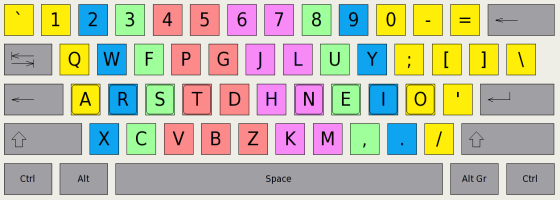As cool as the Colemak keyboard layout is, it is still based on the assumption that people must use the "standard touch typing technique". However, the technique taught to us in typing schools is not necessarily safe ergonomically as it forces the left hand to twist outwards slightly to compensate for the diagonal slant of the key positions.
The Culemak layout is based on a slightly different technique where the left hand rests in a more natural position. The left hand bottom row has effectively been moved one position to the left to allow the fingers to strike the keys under their normal resting positions, reducing the amount of twist in the wrist.
- ‘X’ (qwerty Z) should be struck with the ring finger
- ‘C’ (qwerty X) should be struck with the middle finger
- ‘V’ (qwerty C) should be struck with the index finger
- ‘B’ (qwerty V) should be struck with the index finger
- ‘Z’ (qwerty B) may be struck with either index finger
NOTE: If you use the standard typing technique, Colemak will be more efficient for you. However, if you feel comfortable hitting the QWERTY ‘C’ with your index finger, then Culemak (this layout) will be more efficient.
NOTE: Moving the left bottom row means that the shortcuts have also moved, so Ctrl-Z (Undo) is now in the QWERTY ‘B’ position and Cut, Copy, Paste and Bold have moved one position to the left. Unix users should also beware.
See Switching to Culemak (not Colemak) for more. Also a rudimentary statistical analysis was done in Switching to Colemak Part 4
Installation
Windows Users
Download Culemak.zip and extract it, then follow the directions in the enclosed README.txt.
Mac OSX Users
Download Culemak.keylayout and install it in /Library/Keyboard Layouts/ (system-wide) or in ~/Library/Keyboard Layouts/ (per-user) then reboot. After rebooting, you should be able to select Culemak in the System Preferences -> Keyboard -> Input Sources tab.
Linux Users
Download culemak-1.0.tar.gz and follow the same directions as installing Colemak.
Gentoo Users
- Download Gentoo_overlays.tar.gz and extract it into a
PORTDIR_OVERLAYdirectory, typically something like/usr/local/portage/. - Make sure
PORTDIR_OVERLAYis set in/etc/make.conf emerge sys-apps/colemak sys-apps/culemak
Arch Linux Users
- Create a new temporary directory
$ mkdir /tmp/culemak; cd /tmp/culemak - Download the PKGBUILD file
$ wget -O PKGBUILD http://waddles.org/PKGBUILD.txt - Build the package with
makepkg
$ makepkg - Install with
pacman
$ pacman -U culemak-1.0-1-any.pkg.tar.gz
Other Operating Systems
Modifying Colemak to produce the files for Culemak was really quite easy. If anyone would like to do the same for other operating systems and include their files here, I’ll be happy to include them.

